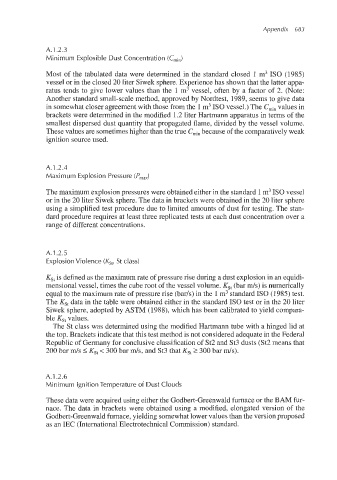Page 716 - Dust Explosions in the Process Industries
P. 716
Appendix 683
A.1.2.3
Minimum Explosible Dust Concentration (Cmin)
Most of the tabulated data were determined in the standard closed 1 m3 IS0 (1985)
vessel or in the closed 20 liter Siwek sphere. Experience has shown that the latter appa-
ratus tends to give lower values than the 1 m3 vessel, often by a factor of 2. (Note:
Another standard small-scale method, approved by Nordtest, 1989, seems to give data
in somewhat closer agreement with those from the 1m3IS0 vessel.) The C,, values in
brackets were determined in the modified 1.2 liter Hartmann apparatus in terms of the
smallest dispersed dust quantity that propagated flame, divided by the vessel volume.
These values are sometimeshigher than the true &,because of the comparativelyweak
ignition source used.
A.1.2.4
Maximum Explosion Pressure (fmJ
The maximum explosion pressures were obtained either in the standard 1m3IS0 vessel
or in the 20 liter Siwek sphere. The data in brackets were obtained in the 20 liter sphere
using a simplified test procedure due to limited amounts of dust for testing. The stan-
dard procedure requires at least three replicated tests at each dust concentration over a
range of different concentrations.
A.1.2.5
ExplosionViolence (Kst, St class)
Ks, is defined as the maximum rate of pressure rise during a dust explosion in an equidi-
mensional vessel, times the cube root of the vessel volume. Ks, (bar m/s) is numerically
equal to the maximum rate of pressure rise (barh) in the 1 m3standard IS0 (1985) test.
The K,, data in the table were obtained either in the standard IS0 test or in the 20 liter
Siwek sphere, adopted by ASTM (1988), which has been calibrated to yield compara-
ble K,, values.
The St class was determined using the modified Hartmann tube with a hinged lid at
the top. Brackets indicate that this test method is not considered adequate in the Federal
Republic of Germany for conclusive classification of St2 and St3 dusts (St2 means that
200 bar ds I K,, < 300 bar ds, and St3 that K,, 2 300 bar ds).
A.1.2.6
Minimum Ignition Temperature of Dust Clouds
These data were acquired using either the Godbert-Greenwald furnace or the BAM fur-
nace. The data in brackets were obtained using a modified, elongated version of the
Godbert-Greenwaldfurnace,yielding somewhat lower values than the version proposed
as an IEC (InternationalElectrotechnical Commission) standard.

